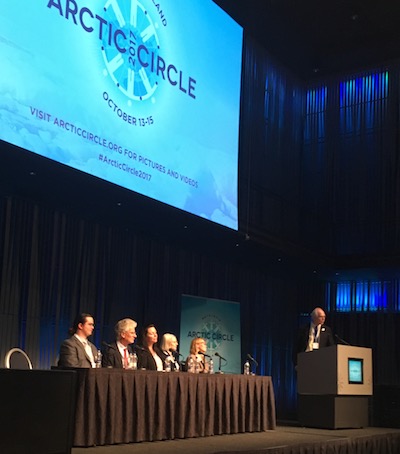
IASC hosted a breakout session at the 2017 Arctic Circle Assembly to discuss Arctic science and business/industry cooperation. Panelists highlighted examples of exchange between the two communities and views on how they aren’t necessarily to separate communities at all! IASC was hoping to discuss case studies, best practices, and lessons learned to lay groundwork for future cooperation. The panel featured a range of participants, including:
- Kelly Drew (Professor, University of Alaska Fairbanks),
- Sara Longan (Executive Director, North Slope Science Initiative),
- Nagruk “Nuk” Harcharek (General Manager, Barrow Arctic Research Center, Ukpeaġvik Iñupiat Corporation)
- Andrea Tilche (Head, Climate Action and Earth Observation Unit, European Commission),
- Toril I. Røe Utvik (Manager, Arctic Unit, Statoil), and
- Moderated by Larry Hinzman (IASC Vice President)
With an audience of over 50 people (including academics, industry representatives, a US Senator from Alaska, and a member of the Greenland Parliament), panelists raised a variety of interesting points, including:
- Basic science in the Arctic can unveil new understandings with global applications.
- There is a need for further investment in research parks and innovation infrastructure in the Arctic.
- Partner organizations (outside of regulatory or industry constraints) can help broker between academic, industry, and public concerns.
- Inclusivity is key to building these relationships.
- Research stations and science support infrastructure can be used as a model for local community science engagement and building local buy-in.
- The case for Arctic science-business cooperation is “trivial” – but cooperation itself can be difficult.
- Arctic observations are increasingly focusing on societal benefit areas. For this, a common, open-access framework has benefits for all.
- Industry can and does invest in Arctic research and development; the key is finding areas of common interest with individual scientists and larger research agencies.
The discussion highlighted the importance of dialogs such as this one, suggested more programs like academic-business secondments and exchanges, and identified building trust and shared incentives as a starting point.
Thank you, again, to our panelists! The IASC Action Group will move forward with further partner consultations and will make recommendations to the IASC Council. If you would like to contribute, please contact the IASC Secretariat.
